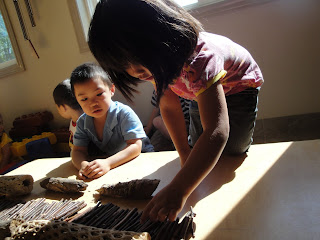
As teachers we are often intrigued by the sustained interest of the children around an experience. How long should we continue to support the topic? When is it time to move on? The answer is as long as the children continue to build knowledge, to ask questions and pose their own theories, as long as we can assist and guide them to construct and reconstruct knowledge.
Sometimes experiences become dormant as the children become captivated by new adventures. And then, much to our surprise, just as an old friend stopping by for an unexpected visit, the children's attention is drawn again to a previous experience. However, we often find the children have new ways of thinking about that old friend!
Such was the case with this group of preschoolers whose classroom often directed their attention to the bridge.Daniel Y began by making two vertical rows with the long cylinders; his two support beams for his bridge. Daniel W and Giacomo then placed small twigs horizontally bridging the two side beams creating a walkway for people.
When they were done Daniel W began counting the twigs from 1 to 30 in stable order. Caitlyn sat close by and listened to him count. She was not convinced that the twigs numbered only 30 in total, "No I think there are more," she said as she began her own count.
She counted from 1 to 99 in stable order and then she turned to the teacher for assistance to finish the count from 100 to 115.
Michael on the other hand was more interested in measuring the bridge. He chose stones as his non standard unit. One side numbered 26 stones in length and the other numbered 22.
The teacher asked, "Why are there 26 stones on one side and 22 on the other?
Michael replied, "You don't know? I will tell you because one side is longer than the other!"











